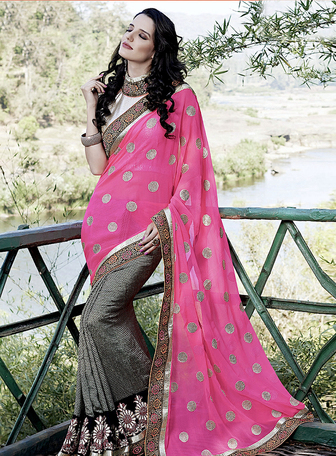The saree is one of the oldest living garments in the world and it is a wonder that this piece of unstitched garment is still surviving even today in all its glory. It is remarkable that the clothing has continued to be there all these hundreds of years without changing in form. There have been changes in styles and ways of draping but the thing in entirety has remained unchanged. It has continued to be a favorite garment of all times for women, and the age old, timeless saree has also served as the canvas and the only means of livelihood for millions of weavers across the country. These poor weavers are extremely talented to produce magnificent designs of sarees according to the specialty of each state or each village, generations after generations. Then there are artists who paint the sarees to create wonderful designs or do the intricate zari or thread work to weave patterns and designs. The jaw-dropping intricate work in the Banarasi sarees is truly commendable, while it is a matter of extreme pride that we have skilled craftsmen in our country who can weave tales from the Puranas, the Ramayana and the Mahabharata with thread on the sarees. The Baluchari sarees of Bengal stand testimony of their skill. It also shows how sarees have transcended just the level of clothing, it is much more. It represents our history and our culture too.
It is believed that the saree emerged in form after the Indus Valley civilization. There is a mention of the sarees in the Vedas and this shows that it is more than 5,000 years old. Women wore a cloth wrapped around the waist and used a shawl to cover the upper portion of their body. It seems the precursor of the splendid nine yards of saree. Gradually came the need to dye clothes and embellish them with thread work and other designs to distinguish them as status symbols. Each state of India is more or less famous for a particular style or design of saree and sometimes one particular village of workers produce such wonderful creations. The resplendent Kanjeevarams and the Sambalpuri sarees for instance are typical examples. The draping styles of the sarees changed according to times, needs and trends.
The saree has been worn both by working class women, fighters in the freedom movement and also as fashionable garments by ladies. Rani Lakshmibai had worn the saree in the typically Maharashtrian style by tucking it like a dhoti which gives enough scope for free movement. Various ancient paintings depict women in sarees and even goddesses in India are adorned in the same garment. Renowned painter Raja Ravi Verma chose the saree to depict the bodies of women in his paintings as he felt it to be the most dignified clothing as well as a sensuous one. It covered the entire body and yet exhibited the contours of a female figure. The saree is a fashionable clothing item that is evergreen with stories of our tradition and can never go out of fashion. Even modern women drape the saree with equal enthusiasm and it is famous worldwide as the saree is a wonderful amalgamation of fashion and art.
This 9 yards drapery today has become more of a modern fashion silhouette to flaunt style and grace all thanks to the Bollywood Divas who leave no chance to endorse the sensuous drapery!
” Discover more such fabulous sarees & styles on Mirraw.com’s – Great Indian Saree Festival from 28-30 September. Tons of choice at great prices. Follow #gisf “







